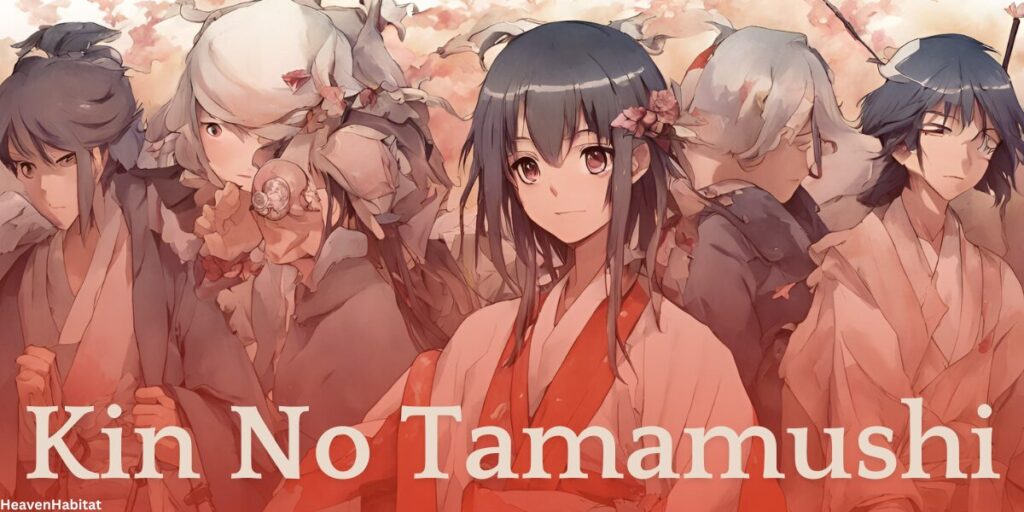Kin no Tamamushi: A Voyage Through Hidden Depths

Kin no Tamamushi, the brainchild of the renowned manga artist Yumi Tamura, isn’t just a historical fiction manga; it’s a meticulously crafted portal to the Heian period (794-1185 AD) of Japan. This era, often romanticized as a golden age of artistic expression, pulsated with vibrant cultural achievements in literature, poetry, and visual arts. Yet, beneath the surface of this dazzling court culture simmered political unrest as the nobility vied for power, and samurai clans began to rise. Tamura masterfully weaves these contrasting elements – the outward beauty and the internal struggles – into the very fabric of Kin no Tamamushi, creating a world that’s both captivating and historically insightful.
Contents [hide]
Delving into the Heian Period:
To fully appreciate the richness of Kin no Tamamushi’s narrative, a deeper dive into the Heian period is necessary. The capital, Heian-kyo (present-day Kyoto), served as the epicenter of this era. It was a city teeming with artistic expression, with advancements in calligraphy, poetry like waka and tanka, and exquisite courtly attire (kimono) becoming hallmarks of the time. However, the political landscape remained a tumultuous one. The imperial court, dominated by powerful clans like the Fujiwaras, struggled to maintain control amidst the growing influence of samurai warriors. This intricate web of social hierarchies, artistic pursuits, and political machinations forms the backdrop for Kin no Tamamushi’s compelling story.
Characters Who Breathe Life into History:
Tamura populates this meticulously recreated world with characters that transcend mere archetypes. Tamayori, our protagonist, stands out as a beacon of defiance. Born into the illustrious Fujiwara clan, she possesses not only a sharp intellect and unwavering determination but also a passion for art that transcends societal expectations placed upon women of her time. Her ambition is to become a kofū – a highly esteemed position serving the emperor, traditionally reserved for men. Tamayori’s journey becomes one of shattering limitations and forging her own path in a world rigidly defined by gender roles.
Shōzō, the Prince with a Gentle Soul:
Juxtaposed against Tamayori’s unwavering ambition is Prince Shōzō, a member of the imperial family. Unlike his power-hungry relatives, Shōzō finds solace in artistic pursuits, particularly calligraphy. He shares Tamayori’s passion for the arts, and their bond transcends the rigid social divide. This unique connection between a headstrong woman and a gentle prince adds a layer of emotional complexity to the story, highlighting the power of shared interests and mutual respect in overcoming societal constraints.
A Plot Steeped in Intrigue and Discovery:
Kin no Tamamushi unfolds with a captivating blend of historical intrigue, personal growth, and the pursuit of dreams. The narrative delves into Tamayori’s relentless efforts to overcome societal barriers and achieve her goal of becoming a kofū. Political machinations within the court threaten to derail her ambitions, while the growing influence of the samurai adds another dimension of complexity.
Historical Figures Come Alive:
The beauty of Kin no Tamamushi lies in its ability to seamlessly blend historical fact with fictional narrative. Readers can expect to encounter real-life figures from the Heian period, such as the renowned calligrapher Fujiwara no Yukinari. These historical figures play crucial roles in shaping Tamayori’s destiny, adding an extra layer of authenticity to the story. The element of discovery becomes paramount as readers become invested in Tamayori’s journey and eagerly await the twists and turns in this captivating historical drama.
Beyond the Pages: Unveiling Profound Themes and Cultural Nuances
The brilliance of Kin no Tamamushi goes beyond its captivating historical setting and intriguing plot. The manga delves into profound themes that resonate deeply with readers:
A Challenge to the Status Quo:
The story champions the power of defying societal expectations. Tamayori’s unwavering determination to become a kofū serves as a powerful message of empowerment, particularly for young women readers struggling with similar societal constraints.
Breaking Down Barriers:
The relationship between Tamayori and Prince Shōzō is a testament to the power of shared passions and mutual respect. It challenges the rigid social hierarchy of the Heian period, highlighting the importance of looking beyond societal positions and connecting on a human level.
A Glimpse into Heian Culture:
Kin no Tamamushi offers a captivating window into the daily life of the Heian nobility. Tamura meticulously recreates court ceremonies, the intricate art of calligraphy, the exquisite details of Heian attire (kimono), and the significance of poetry in daily life. Readers unfamiliar with Japanese culture will find themselves immersed in a world of
Poetry: The Language of the Heart:
Poetry played a central role in Heian court life. Waka, a form of 31-syllable verse, was the preferred form of expression. Tamura incorporates this element beautifully, with characters exchanging poems that reveal their inner thoughts and emotions. Readers unfamiliar with waka can appreciate its beauty through Tamura’s evocative descriptions and the use of imagery. The act of composing and exchanging poems becomes a significant part of the story, highlighting the importance of communication and the power of words.
Courtly Rituals and Traditions:
The Heian nobility adhered to a strict set of rituals and traditions. From elaborate tea ceremonies to the intricate customs surrounding court attire, Tamura meticulously recreates these details, adding a layer of authenticity to the story. Readers get a glimpse into the regimented lifestyle of the nobility and the significance placed on maintaining social order. The contrast between these traditions and Tamayori’s rebellious spirit further emphasizes her struggle for individuality.
The Delicate Art of Appearance:
Heian attire, particularly kimono, was an art form in itself. Layers of silk, vibrant colors, and intricate embroidery signified social status and aesthetic beauty. Tamura’s illustrations meticulously capture the elegance and detail of these garments, offering a visual feast for the reader. The importance of appearance in Heian society is portrayed, highlighting the societal pressure to conform to idealized beauty standards, especially for women.
A Legacy of Storytelling:
Kin no Tamamushi’s impact extends far beyond the realm of entertainment. It has garnered critical acclaim for its historical accuracy and its portrayal of strong female characters. The manga has sparked interest in Heian period Japan, with readers delving deeper into the era’s art, literature, and social structures. Tamura’s work has inspired a new generation to appreciate the beauty and complexity of a bygone age
kin no tamamushi: FAQ’s
Q- What is the Giyuu Punishment comic called?
A: There’s no official title for the comic depicting Giyuu’s punishment. Fans often call it “Giyuu Punishment,” “Kin no Tamamushi Giyuu Punishment,” or similar variations. It’s important to note this comic isn’t part of the official Demon Slayer storyline.
Q- Why did Giyu cry when Tanjiro died?
A: In the official Demon Slayer manga, Giyu doesn’t cry over Tanjiro’s death! Thankfully, Tanjiro survives the series.
Q- Why is Giyu depressed?
A: Giyu’s somberness stems from tragic experiences. He witnessed his sister die protecting him from a demon, and his friend Sabito sacrificed himself during their training. These losses, coupled with the pressure of being a powerful Demon Slayer (Hashira), contribute to his depression.
Q- Why did Sabito slapped Giyu?
A: The Demon Slayer manga doesn’t depict Sabito slapping Giyu. It’s more likely that Sabito rigorously pushed Giyu physically and mentally during their training to prepare him for the dangers of being a Demon Slayer.
A Lasting Impression: Kin no Tamamushi’s Enduring Legacy
Kin no Tamamushi leaves a lasting impression long after the final page is turned. It’s a testament to the enduring power of storytelling, transporting readers to a bygone era and sparking a deeper appreciation for Japanese history and culture. Tamayori’s journey of defiance resonates with readers, leaving them empowered to challenge their own limitations.
The manga’s impact transcends mere entertainment. It serves as a gateway to further exploration of the Heian period. Readers inspired by Kin no Tamamushi may find themselves delving deeper into Heian art, literature, and social structures. The meticulously recreated court rituals, the evocative descriptions of waka poetry, and the stunning portrayals of Heian attire all serve as invitations to delve into the historical context.
Kin no Tamamushi has fostered a dedicated global community. Readers from all walks of life have connected with the story, forming online forums and discussions to share their interpretations and personal connections to the characters and themes. This sense of community further solidifies the manga’s impact, fostering a shared appreciation for history and storytelling.
Whether you’re a seasoned history buff, a manga aficionado, or simply seeking a captivating read, Kin no Tamamushi offers an unparalleled experience. It invites you to embark on a voyage through time, to witness the struggles and triumphs of a young woman defying expectations, and to immerse yourself in the rich tapestry of Heian Japan. So, pick up a copy, join the conversation, and allow yourself to be transported by the magic of Kin no Tamamushi.








1 thought on “Kin no Tamamushi: A Voyage Through Hidden Depths”